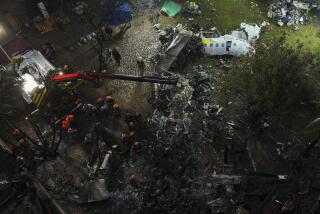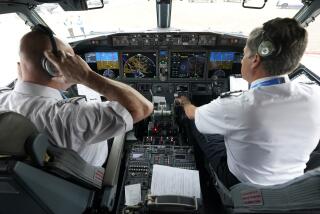Angola Conflict Claims Father-Son Pilots
- Share via
LUANDA, Angola — There was simply no stopping him, Hilton Wilkinson’s mother recalls. A son’s unspoken love for his father is not something to be reasoned with.
“I want to bring Daddy back, dead or alive,” Wilkinson told his mother and two sisters in suburban Johannesburg, South Africa.
The distraught young pilot then left home for this capital city where, until a few months ago, he worked for a charter company.
Wilkinson, 25, boarded United Nations Flight 806A here Jan. 2, but he never found his father, a commercial pilot whose U.N. cargo plane had been shot down eight days earlier. Instead, father and son are both presumed dead, their bodies and twisted aircraft reportedly just miles apart in the disputed central highlands of this warring southern African country.
“My son was taught that cowboys don’t cry,” said Marie Wilkinson, using a popular nickname for pilots who fly in rough-and-tumble conditions, “but the tears were running down his face when he heard about his father.
“We knew it was dangerous for him to go,” she said, “but we didn’t think they could do such a thing a second time.”
The unexplained, back-to-back attacks on U.N. planes that killed as many as 23 people have prompted a dramatic reappraisal of the U.N. observer mission here.
Last week, U.N. Secretary-General Kofi Annan recommended that the U.N. close operations at the end of February, concluding an on-again, off-again peace effort that has spanned a decade and cost more than $1.5 billion.
Planes May Have Flown Too Low
Sources familiar with the two air tragedies, however, say it is likely that both U.N. cargo planes were flying at altitudes considered vulnerable to attack under the U.N.’s own flight procedures.
No one is quite sure why John Wilkinson, Hilton’s father, may have been flying his Hercules C-130 several thousand feet below the 20,000-foot requirement. However, there is little debate about why the second plane may have dipped too low.
“There is no question they were looking for the father,” one source said. “If they had been flying higher, they would not have been hit.”
In a telephone call on New Year’s Eve from Luanda, an excited Hilton Wilkinson told his family that he would follow his father’s ill-fated route to Huambo in the central highlands and “see what I can.”
He intentionally selected a C-130 transport plane to ride in, fellow pilots in Luanda said, because it is the slowest of the cargo aircraft and has the most windows--giving him the best chance of spotting his father’s wreckage.
“Short of tying him and chaining him, you couldn’t have stopped him,” said pilot David Roe, 30, a friend who worked with Wilkinson at Balmoral, a charter company that flies for the World Food Program in Luanda. “When he spoke about his father, he spoke nothing but praise. It was something very special.”
Hilton’s name did not appear on U.N. Flight 806A’s official register, but his father’s friends made sure he got a seat, according to family members.
Wilkinson told his family that the flight’s chief engineer, a longtime family friend and co-worker, extended the invitation, saying: “Come, we are going to go get your daddy.”
Family members say they have no way of knowing if Hilton’s plane was indeed flying too low when it was apparently shot down after leaving Huambo, a provincial capital southeast of Luanda where his father’s plane had also last landed.
The family had considered such a possibility, particularly when Hilton was talking about piloting a small plane himself. His former employers at Balmoral had agreed to make an aircraft available for a scouting expedition, according to several Balmoral pilots, but Hilton was unable to get the necessary air-traffic clearances from the Angolan authorities.
Cargo Aircraft Provided a Ride
In the end, he settled for a ride as a passenger on a U.N. cargo aircraft, which was owned and operated by TransAfrik, a charter company where his father had worked for the last eight years.
“We had more fear when he was going to take his own plane up,” said Hilton’s sister, Anne-Audette. “We were afraid he might do something stupid. We actually felt better he was going with TransAfrik.”
Marie Wilkinson, her exhausted, swollen eyes filling with tears, said her son was desperate.
“If they hadn’t let him on that plane, he would have found another way,” she said. “I can’t blame anybody. We would have all done the same.”
The U.N. safety procedures in Angola include a minimum cruising altitude of 20,000 feet, a drop landing--known as a spiral down--directly above the runway and a swift spiral-up takeoff within a prescribed security zone.
Pilots also are supposed to check for security updates every half-hour. The procedures, U.N. air operation officials say, are intended to keep aircraft out of the likely range of surface-to-air missiles.
The safety procedures were standard practice in Angola until the 1994 peace agreement between the government and the rebel movement, UNITA, brought relative tranquillity to the skies. The procedures were reinstated in mid-December, U.N. officials said, after a low-flying Angolan government plane was shot down and heavy fighting erupted again in much of the country.
Fighting Near Sites Delays Investigation
In the case of John Wilkinson’s plane, the last radio contact indicated it was flying at 15,000 feet and was climbing to 17,000 feet, according to the sources familiar with the incidents. The second plane, the sources said, is believed to have been flying even lower--perhaps 10,000 feet.
Owners of the two downed planes, Sao Tome-based Trans-Afrik, referred questions about the incidents to the U.N., which employs the company in many parts of the world to run its cargo operations.
The U.N. special envoy in Angola, Issa B.Y. Diallo, said in an interview that he did not know whether the TransAfrik planes were flying too low because fighting near the crash sites has prevented the U.N. from conducting a thorough investigation.
“If that is the case, I can’t believe it happened so stupidly,” Diallo said when asked if the planes might have been flying below 20,000 feet.
At this point, the U.N. cannot even verify that Hilton Wilkinson’s plane met the same fate as his father’s because the Angolan government and UNITA have not allowed U.N. investigators near the Jan. 2 crash site, Diallo said. He said he expects to finally get the go-ahead from both sides this week.
It is presumed among many U.N. officials, however, that both planes were gunned down, most probably by UNITA, the Portuguese acronym for the National Union for the Total Independence for Angola. The rebels had control of the territory near Huambo when the planes crashed.
UNITA, which denies the allegation, has been at war with the ruling Popular Movement for the Liberation of Angola almost continuously since Angola gained independence from Portugal in 1975 and is being widely blamed for the recent collapse of the 1994 peace agreement.
However, the truth about the downed flights may never be known: When a U.N. team briefly visited the first crash site Jan. 8, investigators discovered that the cockpit voice recorder had been ripped out and the aircraft had been carefully concealed with branches. Fighting in the area has been so intense that a second visit to remove the bodies and investigate further has been impossible.
“This has been traumatic for us,” Diallo said. “These volunteers for peace don’t deserve this.”
The waiting has been equally difficult at the Wilkinsons’ home near Johannesburg and in an eight-room dormitory near the Luanda airport, where the World Food Program puts up its pilots.
Hilton quit his Luanda job in October to take a course in Connecticut for a U.S. commercial pilot’s license, but his presence is still felt at his former Luanda residence. His pictures, including one in which he’s mooning the photographer, hang above the refrigerator. The kitchen tiles, splashed in graffiti, feature his musings about everything from drinking beer to pursuing women.
Pilot’s Message Quiets Friends
His pilot friends laughed and reminisced one night as they pointed out to a visitor “Hilly’s” contributions. The room fell silent, however, when the group came upon a tile about halfway around the kitchen table.
“Enjoy life while you’re alive,” Hilton had written in black marker. The last word had been rubbed off.
More to Read
Sign up for Essential California
The most important California stories and recommendations in your inbox every morning.
You may occasionally receive promotional content from the Los Angeles Times.













